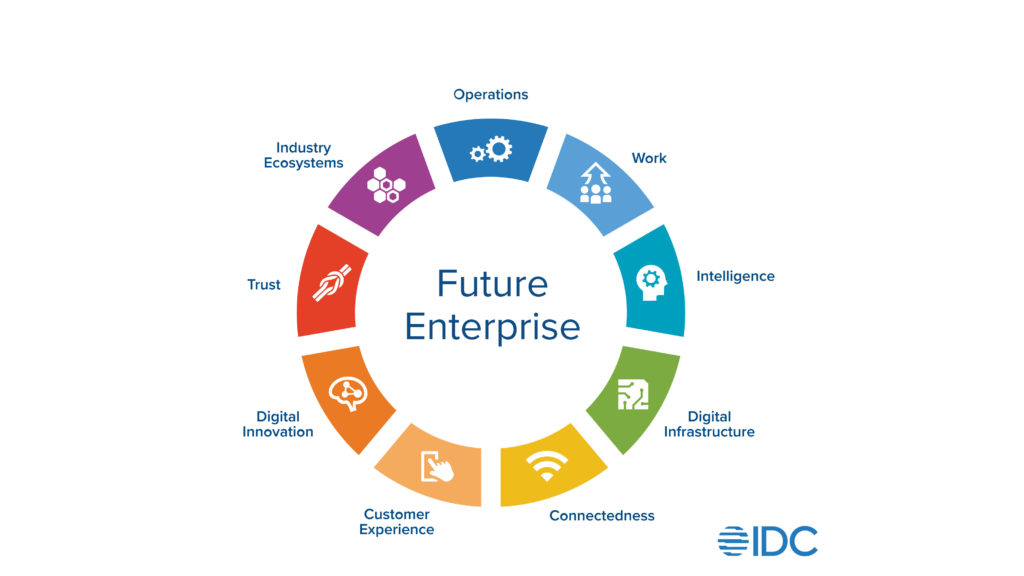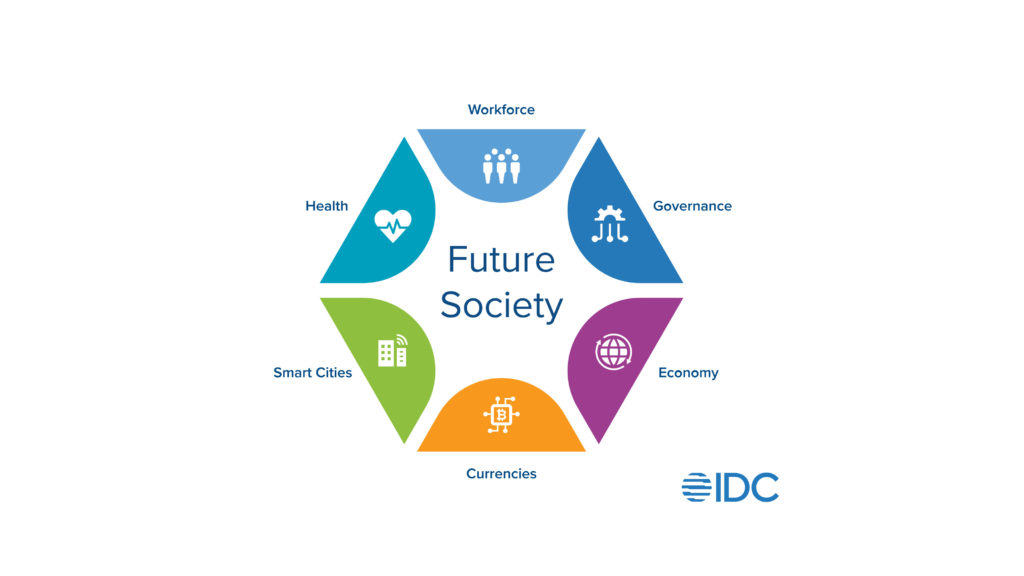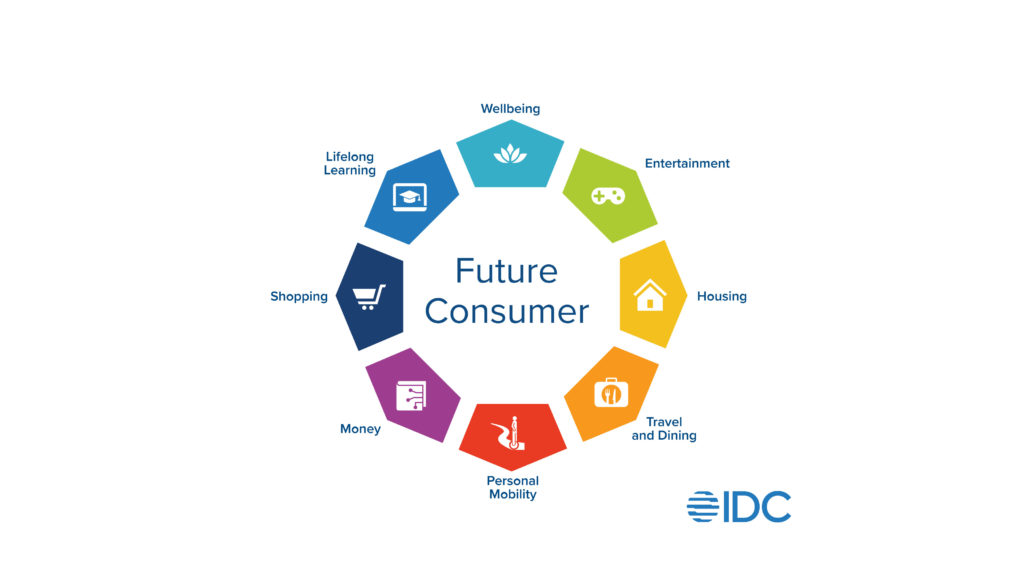The acceleration of technology has transformed the way we interact with each other and businesses, and how we conduct business. We have made enormous progress in digital transformation economically, socially and personally. Large budgets (in the hundreds of millions) are being allocated by big businesses, investing in their digital strategy as the leading way to achieve their growth goals. But what does this mean for you? How do you need to pivot and what technology opportunities exist that will help you change how you support your clients, for future sustainability?
It is important to understand the key parties that make up the digital-first world, and how they interact and conduct exchanges with each other.
- Enterprises: They will create the digital-first business models so they can effectively engage consumers and generate revenue from digital services.
- Government: As consumers spend more of their time online, Governments will recognize the need to reshape their economy to thrive.
- Consumers: They will fuel the digital first world with their digital-first habits.
How Enterprises Will Create Digital-First Business Models
According to our most recent global study, 95% of organizations report they are implementing a digital-first strategy to support new digital revenue streams. By 2027, the average enterprise will see 41% of their revenue come from digital products and services.

By 2027, 41% of an enterprise’s revenue will come from digital products and services.
Download: The new Digital Playbook for B2B Marketers
How Governments Will Digitalize their Economies
As citizens increasingly engage with technology, Governments will seek to influence how digital is used to shape their society and accelerate their own economies. We will see Government investing in creating a digital workforce, developing smart cities, and supporting digital currencies. We will also see Governments putting forth regulations to influence how technology is used in their society, most certainly regarding consumer privacy laws around data and responsible AI.

How Consumers will fuel the digital first world
By 2024, 80% of the world’s population will be online. To get there, we expect an additional 466 million people will come online in the next two years. In 2024, they will spend $10.5 Trillion online, an increase of $1.2 TRILLION in spending from today. While consumer electronics fueled the past two decades of spending, the next two years will be fueled by digital services such as online learning, peer to peer lending, and subscription-based services.

The Digital Tipping Point
As enterprises adopt digital business models, the tech industry will subsequently hit a digital tipping point as it relates to SaaS apps, spending on digital initiatives, and digital talent. Soon, digital will no longer be something for early adopters or even the early majority. Digital will move to the late majority. This will change the way you engage with your customer, what you sell them and how you demonstrate value.
“By the end of this year 52% of the spending on applications will go to SaaS versus 48% to software run on premise.”
There are three foundational elements we expect to occur:
- SaaS adoption. An increased allocation on SaaS, means that enterprises will have a significant portion of their enterprise data running on a cloud-based platform. They will benefit from easier flow of data from one system to another, and greater enterprise intelligence.
- Tech spending on digital initiatives. Tech spending for digital initiatives will soon outweigh spend on non-digital initiatives. This means that that majority of organizations will have achieved the digital transformation goals they planned 3-5 years ago, and will start to experience the agility, innovation and digital revenue that comes with achieving those goals.
- Digital technology skills outnumber non-digital technology skills. By 2024, organizations will begin to win the talent battle for digital technology skills. This means many of them will start to have the support they need for operational support of their digital business.
Related: The Future of Digital Infrastructure
The result of the tipping point will be an emergence of new priorities for customers. They will be asking important questions including:
- How can they cost-effectively scale their digital operations with tech such as cloud and IT automation tools?
- How do they effectively manage data to establish themselves as a trustworthy organization?
- How do they modify the practices of their software development teams to rapidly innovate around digital experiences and services?
Your role will be a critical one, and it is to help your customers attain scale, trust and impact in their digital business, at a time when organizations are worried about their over-expenditure on tech investments. The high costs to create and maintain technology systems will drive organizations to seek out ways to reduce those costs through autonomous operations.
“In our recent study, we found leading organizations in digital infrastructure operations lean heavily on autonomous operations. 84% of them told us they deploy full stack AIOps and AI/ML insights to drive continuous and automated optimization of their digital infrastructure.”
Your clients will be headed toward autonomous operations as they lean more into digital infrastructure, and it is an opportunity for you to provide them with the tools they need.
How to Help Your Customers Thrive in a Digital First World
Your clients need help continuing to create innovative digital experiences and services to fuel their revenue growth. We group these needs in terms of scale, trust and impact.
- Scale: The primary goal for most organizations is cost-effective digital operations. In the past, overspend for the overprovisioning of their infrastructure may have been more common, but it isn’t any longer. Today, there is an opportunity for you to help them optimize cloud spending for architectural benefit and to support their business goals.
- Trust: At the core, most organizations have a vision to be a trustworthy, purpose-driven organization. As your clients seek to be a trustworthy enterprise, they are prioritizing initiatives around cyber security threats, data sovereignty, AI ethics, D&I and environmental sustainability.
- Impact: Organizations are focused on rapid innovation. Those who can quickly respond to changing customer and market dynamics, with digital innovations, attain a competitive advantage.
“43% of tech leaders plan to deliver innovative digital products and services at a faster pace than they have in the past two years.”
A digital-first world is underway, and a typical organization is looking at their role in it in terms of how they can achieve scale, establish trust and make an impact with their customers by driving engagement across product lines. Let this serve as a framework for thinking about the technology opportunities that exist and how you must support your clients as they pivot to being a digital first enterprise.
Related Reading
Technology Strategy, Research and Insights: Ms. Whalen’s international team of 1,100 analysts leverage research and advisory services to empower business transformation for the Global 2000, and counsel technology suppliers on creating effective offerings for the digital economy.
Podcast: The Future of Digital Infrastructure – In conversation with John Hill, Chief Digital and Information Officer at Carhartt, the podcast dives into the radical digital transformation this 132-year-old American apparel company embarked on.





